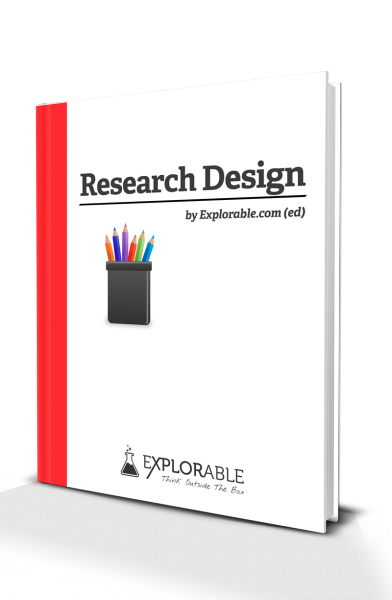Research Designs
 The design is the structure of any scientific work. It gives direction and systematizes the research. Different types of research designs have different advantages and disadvantages.
The design is the structure of any scientific work. It gives direction and systematizes the research. Different types of research designs have different advantages and disadvantages.
This article is a part of the guide:
Browse Full Outline
- 1Research Designs
- 2Basics
- 3Descriptive Research
- 4Covariance
- 5Semi-Experimental
- 6Experimental
- 7Review
The method you choose will affect your results and how you conclude the findings. Most scientists are interested in getting reliable observations that can help the understanding of a phenomenon.
There are two main approaches to a research problem:
What are the difference between Qualitative and Quantitative Research?

Different Research Methods
There are various designs which are used in research, all with specific advantages and disadvantages. Which one the scientist uses, depends on the aims of the study and the nature of the phenomenon:
Descriptive Designs
Aim: Observe and Describe
Correlational Studies
Aim: Predict
- Case Control Study
- Observational Study
- Cohort Study
- Longitudinal Study
- Cross Sectional Study
- Correlational Studies in general
Semi-Experimental Designs
Aim: Determine Causes
Experimental Designs
Aim: Determine Causes
Reviewing Other Research
Aim: Explain
Test Study Before Conducting a Full-Scale Study
Aim: Does the Design Work?
Typical Experimental Designs
Simple Experimental Techniques
- Pretest-Posttest Design
- Control Group
- Randomization
- Randomized Controlled Trials
- Between Subjects Design
- Within Subject Design
Complex Experimental Designs
- Factorial Design
- Solomon Four-Group Design
- Repeated Measures Design
- Counterbalanced Measures Design
- Matched Subjects Design
- Bayesian Probability
Which Method to Choose?
What design you choose depends on different factors.
- What information do you want? The aims of the study.
- The nature of the phenomenon - Is it feasible to collect the data, and if so, would it be valid/reliable?
- How reliable should the information be?
- Is it ethical to conduct the study?
- The cost of the design
- Is there little or much current scientific theory and literature on the topic?
Survey Guide
The full guide - How to create a Survey / Questionnaire
Introduction
Planning a Survey
Questions and Answers
- Constructing Survey Questions
- Questionnaire Layout
- Types of Survey Questions
- Survey Response Scales
- Survey Response Formats
Types of Surveys
- Selecting the Survey Method
- Types of Survey
- Paper-and-pencil Survey
- Personal Interview Survey
- Telephone Survey
- Online Surveys
- Preparing an Online Survey
- Web Survey Tools
- Focus Groups - Pros and Cons
- Panel Study
Conducting the Survey
After the Survey
Resources
Further Reading
- "Research Design: Qualitative, Quantitative, and Mixed Methods Approaches" by John W. Creswell
- "Essentials of Research Design and Methodology" by Geoffrey R Marczyk
Check out our quiz-page with tests about:
Oskar Blakstad (Jun 17, 2008). Research Designs. Retrieved Jan 01, 2026 from Explorable.com: https://explorable.com/research-designs
You Are Allowed To Copy The Text
The text in this article is licensed under the Creative Commons-License Attribution 4.0 International (CC BY 4.0).
This means you're free to copy, share and adapt any parts (or all) of the text in the article, as long as you give appropriate credit and provide a link/reference to this page.
That is it. You don't need our permission to copy the article; just include a link/reference back to this page. You can use it freely (with some kind of link), and we're also okay with people reprinting in publications like books, blogs, newsletters, course-material, papers, wikipedia and presentations (with clear attribution).
Get all these articles in 1 guide
Want the full version to study at home, take to school or just scribble on?
Whether you are an academic novice, or you simply want to brush up your skills, this book will take your academic writing skills to the next level.
Download electronic versions:
- Epub for mobiles and tablets
- PDF version here
This article is a part of the guide:
Browse Full Outline
- 1Research Designs
- 2Basics
- 3Descriptive Research
- 4Covariance
- 5Semi-Experimental
- 6Experimental
- 7Review
Footer bottom





